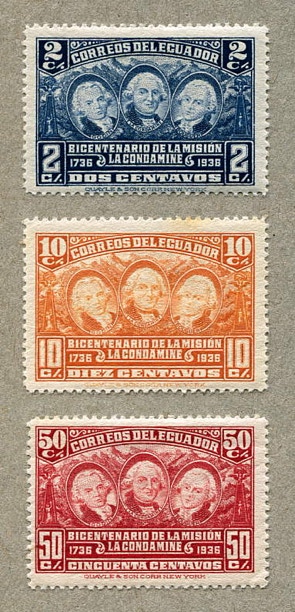Ecuador 1936 – La Condamine expedition
In 1735 and 1736, two French-led expeditions set out to resolve a dispute as to whether the Earth was flattened at the equator, as held by French astronomers, or at the poles, as predicted by Isaac Newton in England. One expedition headed polewards, to Lapland, while the other went equatorwards, to Quito in present-day Ecuador.
The Quito team included Charles Marie de La Condamine (1701–74), a French mathematician and explorer; Pierre Bouguer (1698–1758), a French mathematician and surveyor and a pioneer of astronomical photometry; and Louis Godin (1704–60), a French astronomer. With them were two Spanish scientists, Antonio de Ulloa and Jorge Juan. Each expedition measured the length of a degree of latitude at their respective locations, and their results confirmed Newton’s prediction that the Earth is flattened at the poles.
Ecuador issued a set of stamps to commemorate the bicentenary of the arrival of the French expedition. On the three illustrated here, La Condamine is flanked by Louis Godin (left) and Pierre Bouguer. On two others (5c green and 20c violet) Godin and Bouguer are replaced by the Spaniards Ulloa and Juan. The 10c, 20c, and 50c values were also issued overprinted with the word ‘Aereo’ (SG 534, 535, 536). An additional member of the set (70c grey, SG 537), inscribed ‘Correo Aereo’, shows La Condamine and a local scientist, Pedro Vicente Maldonado, who accompanied La Condamine on his return journey along the Amazon.
As an aside, Ulloa and Juan discovered the valuable element platinum while in Ecuador. On his way back to Spain, Ulloa was captured by the English and taken to London where, on account of his scientific eminence, he was made a Fellow of the Royal Society.
SG number
Face value
Colour
529
2 c
Blue
531
10 c
Orange
533
50 c
Red
